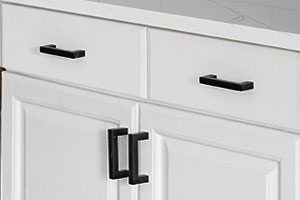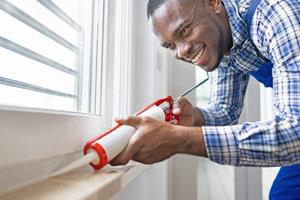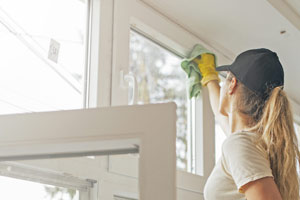Home Maintenance Topics
2-10 Maintenance Guide / Home Maintenance Topics / Interior Maintenance
Interior Maintenance
Attic

- Purchase a mask from your local hardware store to avoid lung irritation from possible airborne insulation fibers.
- Check that all air vents are unobstructed and intact.
- Make sure there are no animals nesting in the insulation.
- If you walk around, be careful not to step on the drywall ceiling below, and watch out for nails sticking through the roof.
- Never store anything in the attic unless it was designed for that purpose. Check with your builder for more information regarding storage capacity.
Cabinets and Countertops

Cabinets
- Inspect the hardware. Adjust, tighten, or lubricate knobs, hinges, latches, rollers, and drawer glides.
- Wood cabinets should be cleaned and waxed just like fine furniture.
- Refresh varnished wood cabinets with a good-quality furniture polish once a month. Never use a paraffin-based spray wax.
- Painted cabinets may be cleaned with a mild, non-abrasive detergent on a damp sponge. Scratches can be filled with a matching touch-up crayon available at most hardware stores.
- Plastic-coated cabinets may be cleaned with a detergent solution.
Laminate Countertops
- Verify that any caulking joints are in good condition and well-adhered to both sides of the joint. Water can cause underlying wood material to swell when wetted. Clean joint and re-caulk with matching material as necessary.
- Avoid placing hot items such as pots, pans, and irons on countertop laminate. Heat can liquefy the underlying glue.
- Never cut on laminate countertops. Always use a cutting board.
- Clean with a mild, non-abrasive detergent on a damp sponge or wash rag. Don’t use scrubby pads.
- Avoid prolonged exposure of dishwasher steam to underside of countertop. High humidity and condensation may cause wood warping under laminate.
Ceramic Countertops
- Inspect grout and tile for cracks. Replace cracked tiles and re-grout as necessary.
- White grout can be refreshed by applying a diluted bleach solution with a stiff narrow brush.
Caulking

- Walk around the house and inspect each caulking joint at the window and door frames, between two different siding materials (like brick or stucco), or around piping that enters the home.
- Confirm that caulked joints are still properly sealed and haven’t cracked, pulled apart, or fallen out. Original caulking will shrink and crack over time due to normal weathering.
- If necessary, clean the old joint out with warm soapy water and a toothbrush and reapply the same caulking material to achieve a proper seal.
- Consult with your local hardware store to select the right type of caulk.
Doors and Windows

- Check window and door integrity and operation.
- Check weather stripping and assure that an airtight seal forms when closed. Replace loose or damaged weather stripping.
- Check door and window hardware (hinges, knobs, pins, latches, locks, etc.). Adjust, tighten, and lubricate where necessary.
- Spray graphite into keyholes and onto hinges when lubricating. Never use oil.
- Make sure door latch bolts and dead bolts engage properly.
- Look for binding or rubbing in the frames, cracked panes, difficult operation, locking problems, and cracking or peeling paint or varnish. Adjust, lubricate, clean, and reseal as necessary.
- Door thresholds can often be adjusted by loosening or tightening the threshold screws. Don’t forget to lubricate the tracks for sliding and pocket doors.
- Paint or seal the top and bottom of doors to reduce moisture penetration and wood shrinking or swelling.
- Don’t sand or plane a door until it has been exposed to the various moisture changes of every season.
- Keep windows clean with mixtures of vinegar, soap, and water. Read more about cleaning windows.
Foundation, Basement, or Crawl Space

On-Slab Foundations
- Walk the entire ground floor and look for water stains or cracks in the concrete.
- Remove stains with an appropriate concrete cleaning agent.
- Seal cracks that may allow water to enter with a compatible waterproof caulk.
- Cleaning agents and caulks can be found at your local hardware store.
Basement Foundation
- Walk the entire floor and perimeter walls. Look for water stains or cracks in the concrete or cinder blocks.
- Remove stains with an appropriate concrete cleaning agent.
- Seal non-structural cracks with a compatible waterproof caulk.
- Cleaning agents and caulks can be found at your local hardware store.
- Inspect sump pit if there is one. If there is standing water in the pit, you may verify that sump is operational by pouring additional water into the pit to trigger the sump pump or install a pump if absent.
Crawl Space Foundation
- Gain access to crawl space through the trap door. Inspect concrete or cinder block walls. Look for water stains or cracks.
- Seal cracks that may allow water to enter with a compatible waterproof caulk. Check ground surface for any standing water.
- Inspect sump pit if applicable. If there is water in the pit, verify that the sump pump is operational by pouring additional water into the pit to trigger the pump or install a pump if absent.
- Locate all air vents. Verify that they’re open and unobstructed by insulation or other debris.
Wall Finishes

Drywall
- Check for cracks at windows, doors, corners, and ceilings. Most drywall cracks will occur after a heating or cooling season with the change in humidity. Air conditioners provide very dry air as they cool.
- Repair with two to three coats of joint compound, sand and repaint when convenient. Minor cracks can be filled with a heavy coat of matching paint.
- Look for any nail pops or protrusions. Reset offending nails deeper into drywall, then repeat drywall repair.
- Consult with a drywall contractor to retexture, as necessary.
Paint or Stain
- Look for peeling, cracking, blistering, fading, or scuff marks. Scrape off paint from any damaged areas.
- Flat paint can be touched up with a small brush and matching paint.
- Semi-gloss and glossy paint can be touched up or wiped off with a damp sponge to clean.
- Exterior paints can usually be used for inside areas. However, the opposite is not always true.
- Do not use an acrylic or latex paint over enamel or varnish, as it will not adhere.
- Use washable paint in the bathroom, kitchen, and utility area.
- Stain can often be rejuvenated with a good quality furniture polish.
- Some painted surfaces may be cleaned with a mild solution of detergent and water. If you are not sure of the wash ability of the paint, try washing in an inconspicuous place.
- Wood paneling should be cleaned with a wood cleaning product and then treated with paneling wax or with linseed oil.
Wallpaper
- Look for loose or curling seams. Changes in humidity can cause seams to separate. Reattach with a compatible wallpaper seam adhesive.
- Keep water and condensation away from all seams.
- Clean surface as necessary with a damp sponge.
Brick or Stone Veneer
- Periodically check for cracks in the mortar. Changes in humidity can cause mortar to shrink.
- Consult with a qualified mason, as necessary, to re-point cracks and match existing mortar.
- Glazed brick or tile should be washed with soap and water. Use a non-abrasive household cleaner to remove stains.
Wood Trim

- Examine all baseboards, chair rails, crown molding, door frames, and window frames. Changing humidity levels can cause wood to shrink, crack, and warp.
- Look for dust accumulation, cracks, corner separations, or warping.
- Wipe off dust with a damp sponge. For stained trim, treat with a good quality furniture polish.
- For cracks or corner separations, fill in gaps with a matching wood putty.
- Treat with furniture polish for stained wood or repaint with a matching color for painted wood.
- Warped trim boards can be resecured with finish nails. Set the finished nail heads slightly into the wood with a nail set tool, then cover nail heads with matching wood putty for stained wood or touch-up paint for painted wood.






